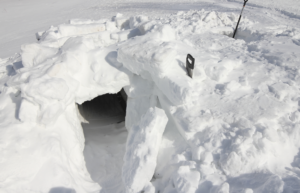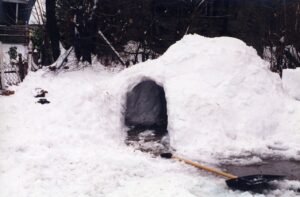Winter survival can be challenging, especially when faced with freezing temperatures and harsh weather conditions. Snow caves, well-known for their insulating properties, offer a warm and secure shelter in extreme circumstances.

This comprehensive guide will explore the design characteristics, benefits, and step-by-step instructions for building a snow cave that effectively traps heat.
Design Characteristics of a Snow Cave:
To maximize its insulating properties and ensure your safety, a properly constructed snow cave should possess the following characteristics:
1. Requires Ample Snow:
Building a snow cave requires a minimum of 4-5 feet of snow. Insufficient snow may not provide enough stability, making other survival shelters, like debris shelters, more suitable.
2. Thick Walls and Rounded Dome Roof:
The walls and roof of a snow cave should be at least 1 foot thick. This thickness ensures structural integrity and improves insulation. The dome-shaped roof allows condensation to roll down the walls rather than drip directly on you, reducing humidity and wetness inside the shelter.
3. Entrance Tunnel below the Main Chamber:
Locating the entrance tunnel below the main chamber offers two significant advantages. Firstly, it prevents wind from entering the cave, ensuring a wind-free environment. Secondly, since warm air rises, having the entrance lower than the main chamber helps trap heat inside the shelter.
Snow Cave vs. Igloo vs. Quinzee:
It’s important to distinguish between snow caves, igloos, and quinzees, as they have different construction methods and purposes.
Snow caves are dug directly into the snow and serve as temporary or emergency shelters. They require significant snow, thick walls, a dome-shaped roof, and a low entrance tunnel that enhances insulation.
Conversely, Igloos are constructed using pre-formed blocks of high-quality snow and are intended to be more semi-permanent dwellings. They require careful construction techniques and extensive manual labor.
Quinzees are similar to snow caves but are built by excavating a large pile of snow. They lack a lower entrance tunnel and the same level of insulation as traditional snow caves.

How to Make a Snow Cave: Step-by-Step Guide
Tools Needed:
1. Sturdy shovel, preferably an avalanche shovel
2. Saw for cutting out large blocks of snow
3. Ski pole or long pole for creating air vents
Time:
Building a snow cave can take around 4+ hours, depending on your experience and the assistance available. It is physically demanding work that involves crawling and crouching, so having a partner to help is ideal.
Step 1: Find the Right Site
- Look for a snowy slope or hill to build your snow cave, allowing you to dig upwards and facilitating the natural flow of excavated snow downhill.
- To ensure safety, avoid cornices, potential avalanche sites, and “widow-maker” trees.
Step 2: Pack Down the Snow
- Ensure that the snow where you plan to build your cave is packed down firmly. Loose, powdery snow may not provide stability for a sturdy shelter.
Step 3: Dig the Entrance Tunnel
- If building on a slope, start digging upwards. If on a flat surface, dig down several feet before starting to dig inwards.
- The entrance tunnel should be dome-shaped, approximately 3 feet high, and 1-2 feet wider than your body.
Step 4: Excavate the Cave Space
- Once you have dug an entrance tunnel about 3 to 5 feet long, begin shaping the main chamber of the snow cave.
- Always shape the ceiling of the snow cave first in a dome shape to ensure structural integrity and help prevent collapse.
- Avoid making the snow cave larger than necessary, as a smaller space will trap more body heat.
Step 5: Keep Walls Thick
- The walls of the snow cave should be at least 1 foot thick to maximize insulation and stability.
- Use sticks as markers, or stop digging when you can see light through the snow walls.
Step 6: Create a Heat Sink
- Dig a pit inside the main chamber to provide a space for cold air to sink, allowing warm air to rise towards the sleeping platforms.
- Consider a T-shape design, with the centerline serving as the heat sink and raised-bed platforms on the sides with a dome ceiling above them for better heat distribution.
Step 7: Smooth the Ceiling
- Ensure the ceiling of the snow cave is as smooth as possible to prevent water drips from melting snow.
- Rough or protruding spots on the ceiling can lead to water dripping onto occupants, compromising their dryness and warmth.
Step 8: Make Air Vents
- Poke air vents along the ceiling of the snow cave using a ski pole, trekking pole, or long stick.
- These vents allow for proper airflow and ventilation inside the cave, preventing snowfall or winds from blocking them.
- Consider leaving one ski pole sticking out of the ceiling as an emergency air hole.
Step 9: Set Roof Support
- To ensure safety, place a hiking pole or branch upright near the head area of the snow cave.
- If the cave collapses while you are inside, the pole will break the snow ceiling, creating an air gap and allowing you to escape.
Step 10: Mark the Cave Location
- To avoid getting lost in the snow, mark your snow cave’s entrance and roof area for easy identification.
- Bright-colored bandanas tied to ski poles can serve as effective markers.
Step 11: Using the Snow Cave
- Block the entrance with snow to keep the wind out and maintain warmth.
- Keep your shovel inside the shelter for easy access if you need to dig out.
- Make a bed using pine boughs or a sleeping pad for insulation from the cold ground.
- Clear any ice that forms on the walls or ceiling, as it reduces ventilation and can lead to suffocation.
- Light a candle or use a candle lantern to provide additional heat inside the snow cave.
Conclusion:
While snow caves can be lifesaving in extreme winter conditions, they are unsuitable for most winter survival situations due to their energy-intensive construction process, the risk of getting sweaty and wet, the need for proper tools, and potential safety hazards.
However, learning how to build a snow cave is still valuable, and practicing it can be fun and educational. Remember to familiarize yourself with other winter survival shelters and techniques to ensure your preparedness in different scenarios. Stay safe and warm in the winter wilderness!


